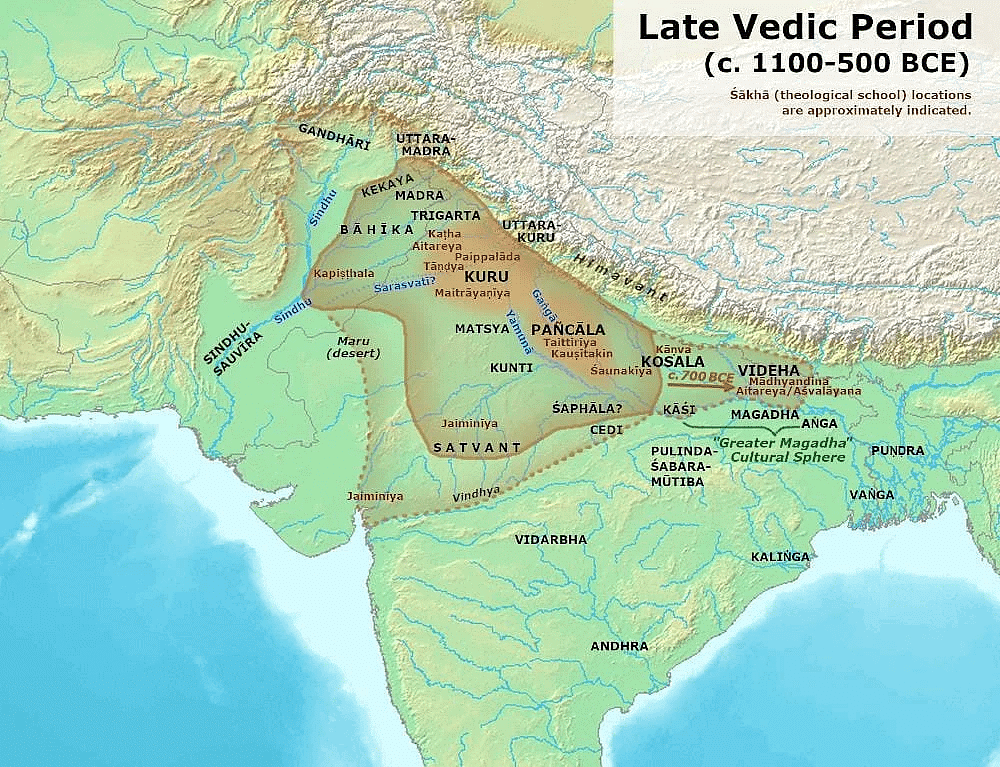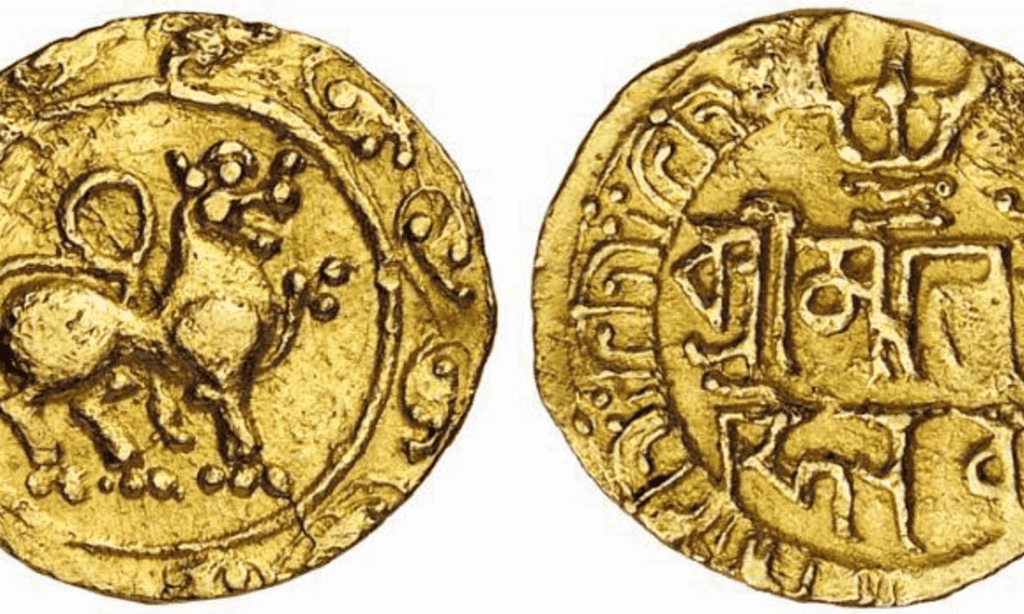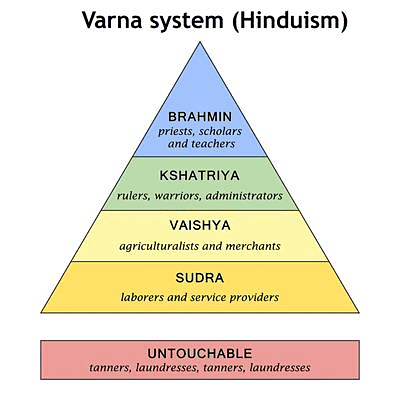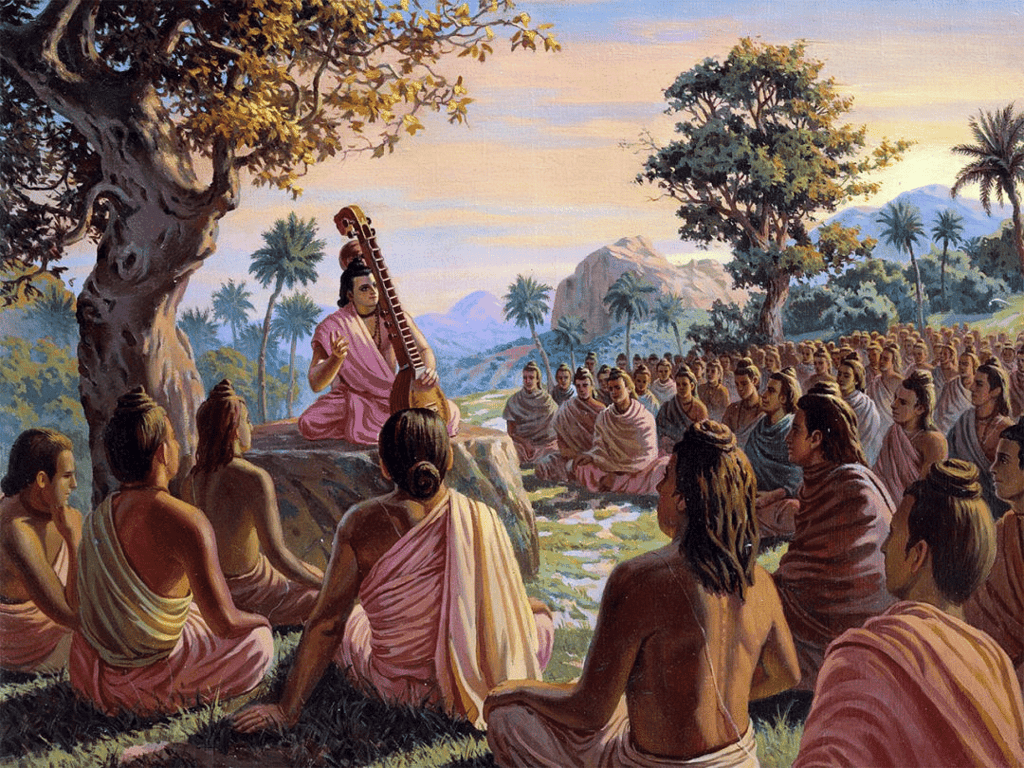Old NCERT Summary (RS Sharma): The Later Vedic Period | History for UPSC CSE PDF Download
| Table of contents |

|
| Expansion in the Later Vedic Period (C.1000 - 500B.C.) |

|
| The PGW— -Iron Phase Culture and Later Vedic Economy |

|
| Political Organization |

|
| Social Organisation |

|
| Good, Rituals said Philosophy |

|
Expansion in the Later Vedic Period (C.1000 - 500B.C.)
- Vedic Texts and Samhitas:
- Later Vedic period knowledge is mainly derived from Vedic texts compiled after the Rig Veda.
- Rig Veda Samhita is the oldest, and Sama Veda Samhita is a modified collection for singing.
- Yajur Veda Samhita includes hymns and rituals, while Atharva Veda focuses on charms and spells.
- Brahmanas and Compilation:
- Later Vedic texts include Br'ahmanas explaining rituals and social aspects.
- Compiled in the upper Gangetic basin around 1000-600 B.C.
- Archaeological Evidence - Painted Grey Ware (PGW) Sites:
- Around 500 PGW sites found in western Uttar Pradesh, Punjab, Haryana, and Rajasthan.
- Inhabitants used painted grey pottery and iron weapons.
- Expansion of Aryans:
- Aryans expanded from Punjab to western Uttar Pradesh (Ganga-Yamuna doab).
- Bharatas and Purus combined to form the Kuru people, initially living between the Sarasvati and Drishadvati rivers.
- Kuru-Panchala Kingdom:
- Kuru tribe expanded to Delhi and upper doab; coalesced with Panchalas in the middle doab.
- Capital at Hastinapur, involved in the Mahabharata's Bharata battle around 950 B.C.
- Hastinapur Excavations:
- Excavations at Hastinapur (900 B.C. to 500 B.C.) revealed settlements, but not as described in the Mahabharata.
- Hastinapur was flooded, leading remnants of the Kuru clan to move to Kausambi near Allahabad.
- Panchala Kingdom:
- Panchala kingdom covered modern Bareilley, Badaun, and Farukhabad districts.
- Known for philosopher kings and Brahmana theologians.
- Eastern Expansion:
- Around 600 B.C., Vedic people expanded further east to Kosala in eastern Uttar Pradesh and Videha in north Bihar.
- Encounters with Other Cultures:
- Encounters with people using copper implements and black-and-red earthen pots.
- Possible encounters with late Harappan culture, but not well-defined.
- Expansion Success Factors: Vedic people succeeded in expansion due to iron weapons and horse-drawn chariots.
In summary, the later Vedic period saw the compilation of Vedic texts, archaeological evidence from PGW sites, the expansion of Aryans into the Gangetic basin, the Kuru-Panchala kingdom, excavations at Hastinapur, and encounters with diverse cultures during their expansion.
The PGW— -Iron Phase Culture and Later Vedic Economy
- Introduction of Iron:
- Around 1000 B.C., iron usage began in the Gandhara area (Pakistan) and Baluchistan.
- Iron implements were found in eastern Punjab, western Uttar Pradesh, and Rajasthan around the same time.
- Iron Weapons and Agriculture:
- Iron weapons, like arrowheads and spearheads, became common in western Uttar Pradesh by 800 B.C.
- Iron was likely used to clear forests in the upper Gangetic basin.
- Agriculture was the primary livelihood despite primitive tools and scarcity of bullocks.
- Rise of Rice and Wheat:
- Barley continued, but rice and wheat became chief crops during the later Vedic period.
- Vedic people encountered rice in the doab, called "vrihi" in Vedic texts.
- Arts and Crafts:
- Diverse arts and crafts emerged, including smiths and smelters working with iron.
- Weaving, leatherwork, pottery, carpentry, and jewelry-making progressed.
- Four types of pottery: black-and-red ware, black-slipped ware, painted grey ware, and red ware.
- Painted Grey Ware (PGW) was distinctive, and used for rituals and eating.
- Settled Life and Agriculture:
- Agriculture and crafts allowed for a settled life.
- Painted grey ware sites are found in western Uttar Pradesh, Delhi, Panjab, Haryana, and Rajasthan.
- Nearly 500 sites, mainly in the upper Gangetic basin, with evidence of settled life.
- Mud brick and cattle-and-daub houses were discovered in excavations.
- Primitive Towns and Commerce:
- Primitive towns like Hastinapur and Kausambi emerged at the end of the later Vedic period.
- Proto-urban sites with limited town features.
- Vedic texts mentioned seas and sea voyages, hinting at some commerce.
- Material Progress:
- Later Vedic phase marked a material advance.
- Pastoral and semi-nomadic lifestyles gave way to settled agricultural communities.
- Agriculture became the primary source of livelihood.
- Diverse arts and crafts supplemented settled life in the upper Gangetic plains.
Political Organization
- Shift in Political Dynamics:
- In the later Vedic period, popular assemblies like vidatha lost importance, and royal power increased.
- The vidatha disappeared, while sabha and samiti continued but with changed characteristics.
- Assemblies came to be dominated by princes and wealthy nobles.
- Women were excluded from the sabha, and the assembly was now dominated by nobles and Brahmanas.
Formation of Wider Kingdoms:
- Wider kingdoms led to increased royal power.
- Tribal authority became territorial as princes ruled over tribes, and their dominant tribes became associated with specific territories.
- The tribal name eventually became the territorial name, indicating the shift from tribal to territorial authority.
- The term "rashtra" (territory) first appeared in this period.
King's Influence and Rituals:
- The king's influence was strengthened through rituals like rajasuya (conferring supreme power), asvamedha (unquestioned control over a region), and vajapeya (chariot race to showcase royal prestige).
- Rituals impressed people with the king's increasing power and prestige.
Taxation and Tribute:
- The collection of taxes and tributes became common during this period.
- These revenues were likely deposited with an officer called "sangrihitri ."
- Administration and Village Assemblies:
- The king, assisted by the priest, commander, chief queen, and high functionaries, administered duties at a higher level.
- At the lower level, administration may have been carried out by village assemblies controlled by chiefs of dominant tribes.
- These assemblies were responsible for local case trials.
- Even in later Vedic times, kings did not have standing armies; tribal units were mustered during times of war.
In summary, the later Vedic period witnessed a shift towards increased royal power, the formation of wider kingdoms, the use of rituals to strengthen the king's influence, the introduction of taxation and tribute collection, and a decentralized administration involving village assemblies and tribal units in times of war.
Social Organisation
- Varna System:
- Later Vedic society was divided into four varnas: Brahmins, Kshatriyas (or Rajanyas), Vaishyas, and Shudras.
- The Brahmanas gained significant power due to the growing cult of sacrifice.
- Roles of Varnas:
- Vaishyas constituted common people involved in producing functions like agriculture, cattle breeding, and trade.
- Brahmanas and Kshatriyas lived on tributes collected from the vaishyas, with the priests aiding in this process.
- Upanayana, sacred thread ceremonies, were common for the first three varnas, while Shudras were deprived of these rituals.
- Varna Distinctions:
- Vedic texts marked a clear distinction between the higher orders (Brahmanas, Kshatriyas, vaishyas) and the Shudras.
- Shudras participated in certain public rituals, indicating survival as the original Aryan people.
- Some artisans, like chariot makers, enjoyed high status and received the sacred thread ceremony.
- Family Structure:
- The increasing power of the father was observed in family structures, including the ability to disinherit a son.
- Primogeniture became stronger in princely families.
- Male ancestors were worshipped, and women generally held a subordinate position.
- Gotra and Exogamy:
- The institution of gotra emerged, signifying descent from a common ancestor.
- Gotra exogamy became a practice, prohibiting marriages between individuals of the same gotra or lineage.
- Ashramas - Stages of Life:
- Ashramas, the four stages of life, were not well-established in Vedic times.
- Post-Vedic texts mention four ashramas: Brahmachari (student), Grihasth (householder), Vanaprastha (hermit), and Sannyasin (ascetic).
- In later Vedic times, only the first three stages were commonly practiced; the ascetic stage was not well-established.
Good, Rituals said Philosophy
- Evolution of Vedic Deities:
- In later Vedic times, the importance of Rig Vedic gods Indra and Agni declined.
- Prajapati, the creator, became the supreme deity in the later Vedic pantheon.
- Other minor gods from the Rig Vedic period gained prominence, such as Rudra (god of animals) and Vishnu (conceived as the preserver and protector).
- Symbolic Worship and Idolatry:
- Some objects started being worshiped as symbols of divinity, indicating signs of idolatry in later Vedic times.
- Pushan, originally associated with cattle, came to be regarded as the god of the shudras.
- Change in Worship Practices:
- People continued worshiping gods for material reasons, but the mode of worship changed significantly.
- Prayers were still recited, but sacrifices became more important, assuming both public and domestic characteristics.
- Sacrifices involved the large-scale killing of animals and the destruction of cattle wealth.
- Role of Priests and Sacrificer:
- Guests in sacrifices were known as "goghna" or those fed on cattle.
- The sacrificer, known as the yajamana, played a crucial role, and success depended on correctly uttering magical formulae during sacrifices.
- Sacrificial gifts included cows, gold, cloth, horses, and sometimes portions of territory as dakshina (offering).
- Philosophical Reaction and Upanishads:
- Towards the end of the Vedic period, a strong reaction against priestly domination, cults, and rituals emerged.
- The Upanishads were compiled around 600 B.C., particularly in the lands of the Panchalas and Videha.
- These philosophical texts criticized rituals, emphasizing the importance of right belief and knowledge.
- They stressed the acquisition of knowledge of the self (atman) and understanding the relationship of atman with Brahma.
In summary, the later Vedic period saw a shift in the prominence of deities, a change in worship practices with an increased focus on sacrifices, the role of priests and sacrificers in rituals, the emergence of symbolic worship and idolatry, and a philosophical reaction against priestly dominance leading to the compilation of the Upanishads.
|
216 videos|855 docs|219 tests
|
FAQs on Old NCERT Summary (RS Sharma): The Later Vedic Period - History for UPSC CSE
| 1. What is the significance of the PGW (Painted Grey Ware) culture in the Iron Phase during the Later Vedic Period? |  |
| 2. How was the political organization during the Later Vedic Period? |  |
| 3. What were some key features of the social organization in the Later Vedic Period? |  |
| 4. What role did rituals and philosophy play in the Later Vedic Period? |  |
| 5. What is the significance of the economy during the Later Vedic Period? |  |




















